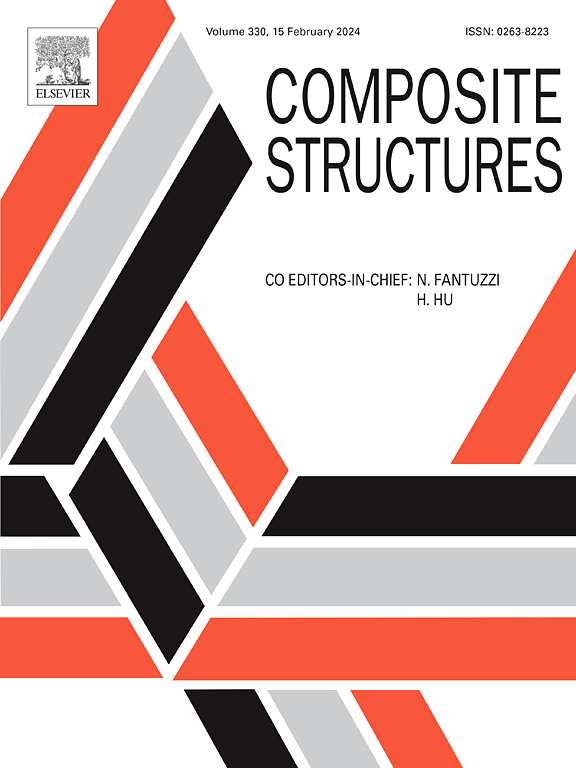考虑弯曲凹六边形蜂窝夹层结构模态特性的等效力学参数优化等效模型的建立
IF 6.3
2区 材料科学
Q1 MATERIALS SCIENCE, COMPOSITES
引用次数: 0
摘要
弯曲夹层结构具有更均匀的应力分布和优越的流体力学性能,凹六边形蜂窝结构具有优异的抗振和吸能性能。建立等效模型可以显著提高优化设计和性能分析的效率,且模型的可靠性和精度直接关系到蜂窝芯等效力学参数的准确性。模态行为分析可以有效地预防共振引起的结构损伤和破坏,对夹层结构的动力设计尤为重要。为此,提出了一种考虑模态行为对等效力学参数影响的弯曲六边形蜂窝夹层结构等效模型建立方法。将得到的岩心面内外方向等效力学参数与夹层板理论相结合,建立了初步的等效模型。对采用光敏树脂芯和碳纤维面板的弯曲凹六边形蜂窝夹层结构进行三点弯曲试验,并将试验数据与实际模型和初步等效模型的有限元结果进行了比较。通过遗传算法优化芯的等效力学参数(即芯等效模型的材料性能),使等效模型的前四个模态频率与实际模型的平均相对误差最小,并通过模态分析进一步了解修正等效模型的精度提高。结果表明,实际模型和初步等效模型的模拟载荷-位移曲线与实际模型的试验数据基本一致,对考虑模态行为的岩心等效力学参数进行优化,显著减小了等效模型与实际模型之间的相对误差。本文章由计算机程序翻译,如有差异,请以英文原文为准。
Equivalent model establishment based on the equivalent mechanical parameters optimization considering the modal behavior for curved concave hexagonal honeycomb sandwich structures
The curved sandwich structure has more uniform stress distribution and superior fluid dynamics performance, and the concave hexagonal honeycomb presents excellent anti-vibration and energy absorption. Establishing an equivalent model can significantly improve the efficiency of optimization design and performance analysis, and the reliability and precision of the model are directly associated with the accuracy of equivalent mechanical parameters of the honeycomb core. Modal behavior analysis can prevent the structural damage and failure caused by the resonance, and is particularly important to the dynamic design of sandwich structures. Hence, an equivalent model establishment method considering the influence of the modal behavior on the equivalent mechanical parameters is developed for the curved sandwich structure with concave hexagonal honeycomb. A preliminary equivalent model is established by combining the derived equivalent mechanical parameters along the in-plane and out-of-plane directions of the core with the sandwich panel theory. Three-point bending tests are performed on curved concave hexagonal honeycomb sandwich structures with photosensitive resin core and carbon fiber face sheets, and the test data are compared with the finite element results of actual models and preliminary equivalent models. The equivalent mechanical parameters of the core (i.e., the material properties of the core’s equivalent model) are optimized by a genetic algorithm to minimize the average relative error between the first four modal frequencies of the equivalent model and those of the actual model, and the accuracy improvement of modified equivalent model is further understood through modal analysis. The results show that the simulated load–displacement curves of actual model and preliminary equivalent model are basically consistent with the test data of the actual model, and optimizing the equivalent mechanical parameters of the core, in which the modal behavior is considered, significantly reduces the relative errors between the equivalent model and actual model.
求助全文
通过发布文献求助,成功后即可免费获取论文全文。
去求助
来源期刊

Composite Structures
工程技术-材料科学:复合
CiteScore
12.00
自引率
12.70%
发文量
1246
审稿时长
78 days
期刊介绍:
The past few decades have seen outstanding advances in the use of composite materials in structural applications. There can be little doubt that, within engineering circles, composites have revolutionised traditional design concepts and made possible an unparalleled range of new and exciting possibilities as viable materials for construction. Composite Structures, an International Journal, disseminates knowledge between users, manufacturers, designers and researchers involved in structures or structural components manufactured using composite materials.
The journal publishes papers which contribute to knowledge in the use of composite materials in engineering structures. Papers deal with design, research and development studies, experimental investigations, theoretical analysis and fabrication techniques relevant to the application of composites in load-bearing components for assemblies, ranging from individual components such as plates and shells to complete composite structures.
 求助内容:
求助内容: 应助结果提醒方式:
应助结果提醒方式:


